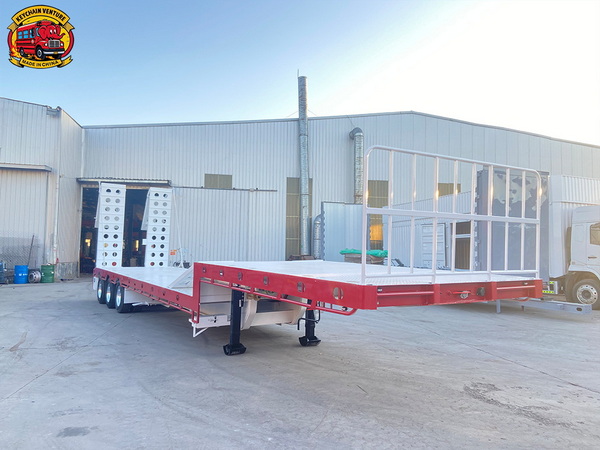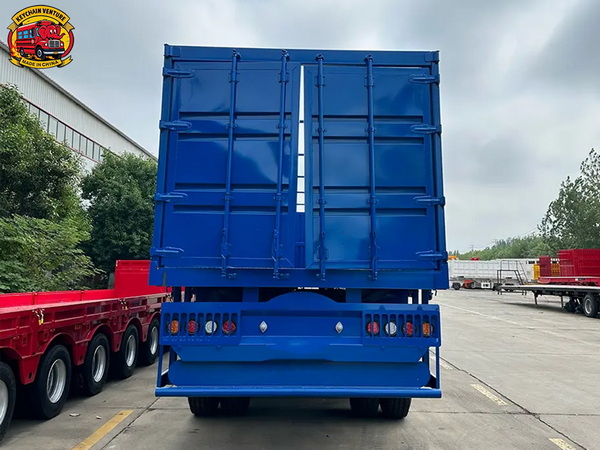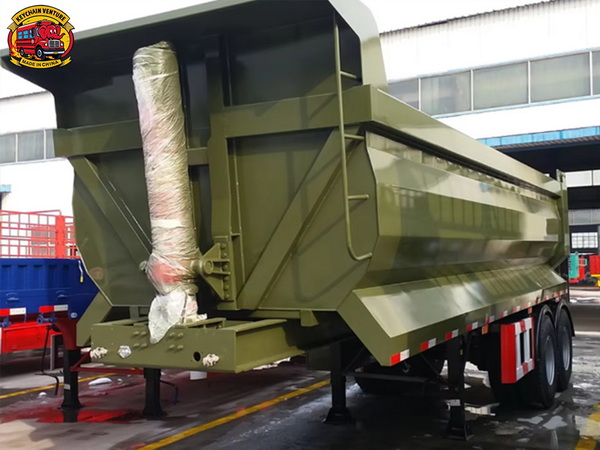Views: 222 Author: Amanda Publish Time: 2025-10-10 Origin: Site








Content Menu
● Understanding Air Brake Systems on Semi Trailers
● How Air Brakes Function in Detail
● Drum Brakes vs. Disc Brakes on Semi Trailers
>> Drum Brakes
>> Disc Brakes
● Key Components and Control Systems of Air Brakes
● Safety Features in Semi Trailer Air Brake Systems
● Operation Under Various Conditions
● Frequently Asked Questions (FAQs)
>> 1. How does air pressure apply the brakes on a semi trailer?
>> 2. What happens if the air pressure fails while driving?
>> 3. Why do semi trailers use two separate air lines (red and yellow)?
>> 4. How often should the air brake system be inspected?
>> 5. Are air brakes more reliable than hydraulic brakes for semi trailers?
Air brakes on semi trailers are a fundamental safety technology designed to reliably and effectively stop these large, heavy vehicles. Unlike traditional hydraulic brakes used in smaller vehicles, air brakes employ compressed air to apply braking force, which is especially suited to handle the immense weight and operational demands of commercial semi trailers. This comprehensive guide explores how air brakes function on semi trailers, the components involved, their operational details, and why these systems are essential for highway safety.

An air brake system replaces hydraulic fluid with compressed air as the medium of transmitting braking force. When the driver presses the brake pedal, compressed air stored in reservoir tanks is released through a network of valves and air lines to brake chambers located at each wheel. The force of the compressed air inside these brake chambers transforms into mechanical pressure, pressing the brake shoes against the rotating drum or disc attached to the wheel. This action slows or stops the semi trailer by creating friction.
The system comprises several crucial components working cohesively:
- Air Compressor: Typically engine-driven, this unit compresses ambient air and supplies it to the air reservoirs.
- Air Reservoirs: Large tanks that store compressed air until the brakes need to be applied.
- Brake Pedal Valve (Foot Valve): The driver's brake pedal controls how much compressed air is routed to the brake chambers.
- Brake Chambers: Cylinders on each wheel that convert air pressure into mechanical push force.
- Slack Adjusters and Camshafts: Mechanical linkages that translate the pushrod force from the brake chambers into rotational motion to apply the brakes.
- Brake Shoes and Drums/Discs: Contact components that physically create friction to slow or stop the wheels.
- Spring Brakes: Special brake chambers that use powerful springs to apply the parking brake and emergency brakes, activating automatically if air pressure is lost.
The parking brake system relies on these spring brakes. Air pressure in the spring brake chambers keeps strong springs compressed. When the driver engages the parking brake or if the system loses air pressure, the springs automatically expand to apply the brakes, preventing unintended movement. This fail-safe feature is vital for safety.
Pushing the brake pedal sends compressed air from the reservoirs through the brake valve to each brake chamber. Inside every brake chamber, the air pressure forces a diaphragm to move a pushrod outward. This pushrod moves the slack adjuster and camshaft, which mechanically rotate and force the brake shoes outward against the inner surface of the brake drum or disc rotor.
The friction between the brake shoes and drum (or disc pads and rotor) slows wheel rotation, thereby reducing vehicle speed or bringing it to a stop. When the driver releases the pedal, the air pressure in the brake chambers is exhausted through quick-release valves, allowing springs to retract the brake shoes and release the brakes.
This process happens almost instantly whenever braking is needed, allowing for frequent and effective braking even under the demanding conditions of heavy loads and variable road terrain.
Drum brakes operate by pressing brake shoes outward against the interior surface of a rotating drum attached to the wheel. They rely on the camshaft mechanism to convert linear force into rotational force and then into friction. Drum brakes are the most common type on semi trailers due to their durability and effectiveness under heavy loads.
Disc brakes consist of calipers that squeeze brake pads against a rotating disc (rotor) mounted to the wheel hub. They offer superior heat dissipation, better stopping power, and quicker response times but usually require more maintenance. Some modern semi trailers use disc brakes especially for front axles or high-performance applications.
When the driver applies the brakes, air pressure activates the brake chamber piston that moves the caliper, clamping the pads onto the rotor and slowing the wheel. Upon release, springs retract the caliper and brake pads, freeing the rotor.

- Air Compressor & Governor: Driven by the engine, the air compressor pumps air into the reservoirs. It is regulated by an air governor that turns the compressor on and off based on preset air pressure limits to keep the system within safe pressure ranges.
- Air Dryer: Removes moisture and contaminants from the compressed air, preventing corrosion and freezing inside the brake system.
- Reservoir Tanks: Store compressed air and supply it to various brake system circuits.
- Dual Control Foot Valve: Contains two valves operating simultaneously to distribute air from two segregated reservoirs to the front and rear brakes for redundancy and safety.
- Two-way Check Valve: Allows the system with the highest pressure between primary and secondary air systems to actuate trailer brakes and controls brake lights activation.
- Relay Valves: Positioned strategically especially on long trailers, relay valves boost the speed of air delivery to rear brakes, improving braking response.
- Brake Chambers & Slack Adjusters: Convert air pressure into pushing force and adjust the brake shoe-to-drum distance automatically to compensate for brake wear.
- Spring Brake Chambers: Provide parking and emergency brake functions through mechanically stored spring force.
Air brake systems on semi trailers are equipped with numerous safety mechanisms to ensure safe operation:
- Dual Air Circuits: Independent primary and secondary air systems ensure that if one circuit fails, the other can still stop the vehicle.
- Pressure Gauges: Dashboard-mounted gauges constantly monitor air pressure in various reservoirs, helping drivers ensure adequate system operation.
- Wig Wag Warning Device: A mechanical or electronic alert that signals the driver if air pressure drops below a safe threshold.
- Emergency Brake Activation: If the trailer disconnects or air pressure drops critically, the spring brakes automatically engage to prevent runaways.
- Automatic Slack Adjusters: Maintain proper brake shoe clearance to ensure effective and responsive braking at all times.
- Normal Braking: Compressors maintain system pressure. The driver modulates brake pedal, adjusting air flow to brake chambers, gently or firmly slowing the semi trailer.
- Emergency Braking: Sudden loss of air pressure or intentional parking brake application activates spring brakes, using stored mechanical energy to apply full braking force.
- Failure Scenarios: In event of air leaks or compressor failure, the design ensures brakes automatically engage, stopping the vehicle safely.
Routine inspection and maintenance are critical for air brake systems to function correctly:
- Daily pre-trip checks should include inspecting air pressure levels, listening for leaks, and testing brake responsiveness.
- Regular draining of water and oil from air reservoirs is necessary to prevent freezing and corrosion.
- Periodic adjustment, repair, or replacement of worn brake shoes, drums, pads, and chambers must follow manufacturer and regulatory guidelines.
- Proper lubrication of slack adjusters and verification of spring brake chamber functionality are essential to prevent brake failure.
- System diagnostic tools and manual inspection by qualified technicians help identify issues before they lead to system failure.
Air brakes represent a vital technology that enables the safe and efficient slowing and stopping of semi trailers. The use of compressed air rather than hydraulic fluid makes these systems particularly reliable for the heavy loads and challenging operating conditions that semi trailers face every day. Their fail-safe design, including spring-applied parking brakes and dual air circuits, provides an extra layer of safety critical to preventing accidents. Understanding the detailed workings of air brakes—from compressors and valves to brake chambers and slack adjusters—is essential for drivers, fleet operators, and maintenance personnel to ensure the longevity, reliability, and safety of semi trailer fleets on the road.

Air pressure from reservoirs flows into brake chambers where it pushes a diaphragm connected to a pushrod. This mechanical force is transferred via slack adjusters to rotate the camshaft, forcing brake shoes against the drum or pads against the rotor to slow or stop the wheels.
If air pressure drops below safe levels or is lost due to leaks or disconnection, spring brakes automatically engage using strong mechanical springs to apply emergency brakes and bring the semi trailer safely to a stop.
The yellow air line controls the service brakes, providing normal braking during driving, while the red air line controls emergency and parking brakes. This separation ensures redundancy and safety if one line fails.
Drivers should perform daily inspections checking air pressure and listening for leaks. Professional maintenance and safety inspections should be done regularly in accordance with guidelines from vehicle manufacturers and transportation authorities.
Yes, air brakes are more reliable for heavy vehicles because they have a fail-safe design, use an unlimited supply of compressed air instead of hydraulic fluid, and provide consistent powerful braking needed for the large mass of semi trailers.
[1](https://www.ccjdigital.com/maintenance/article/15290514/the-anatomy-of-a-trucks-air-brake-system)
[2](https://www.youtube.com/watch?v=fbT_MFZLP9s)
[3](https://www.uti.edu/blog/diesel/air-brakes)
[4](https://burkholdertrailers.com/air-brake-trailers-for-sale/)
[5](https://www.wondee.com/How-Semi-Trailer-Braking-Systems-Work-A-Complete-Guide-id43360306.html)
[6](http://www.ontario.ca/document/official-ministry-transportation-mto-drivers-handbook/trailer-brake-subsystem)
[7](https://sgi.sk.ca/air-brake/-/knowledge_base/air-brake/simple-tractor-trailer-system)
[8](https://qr.dmv.ca.gov/portal/handbook/commercial-driver-handbook/section-5-air-brakes/)
[9](https://www.inf.gov.nt.ca/sites/inf/files/resources/air_brake.pdf)
[10](https://tc.canada.ca/sites/default/files/migrated/121_tsd_en_rev_4r.pdf)